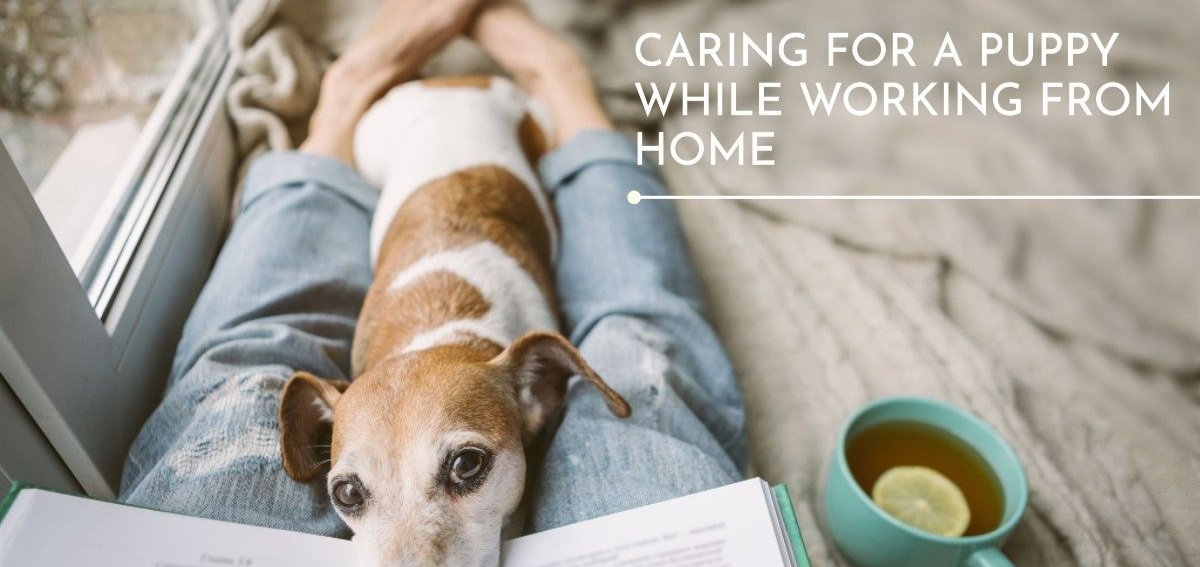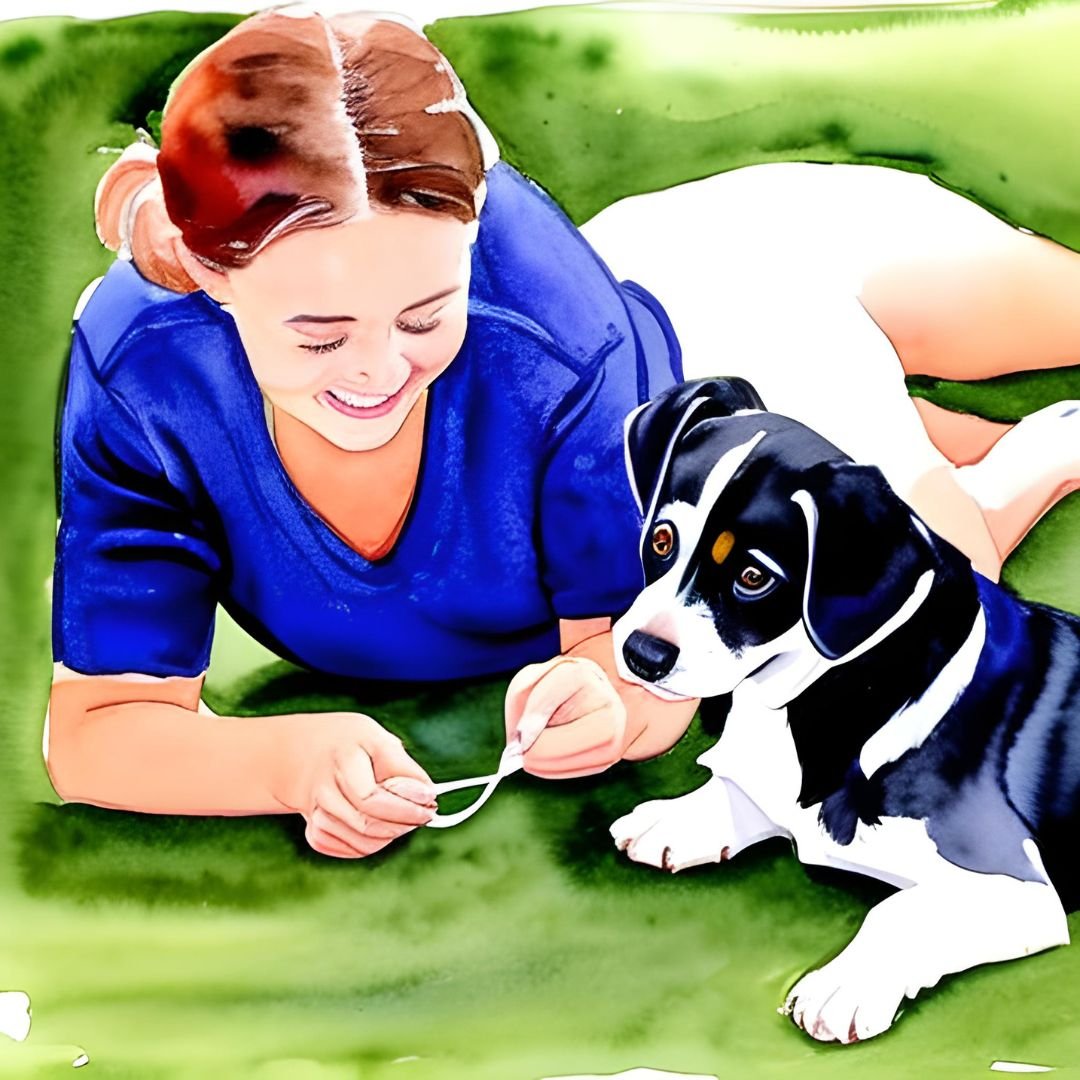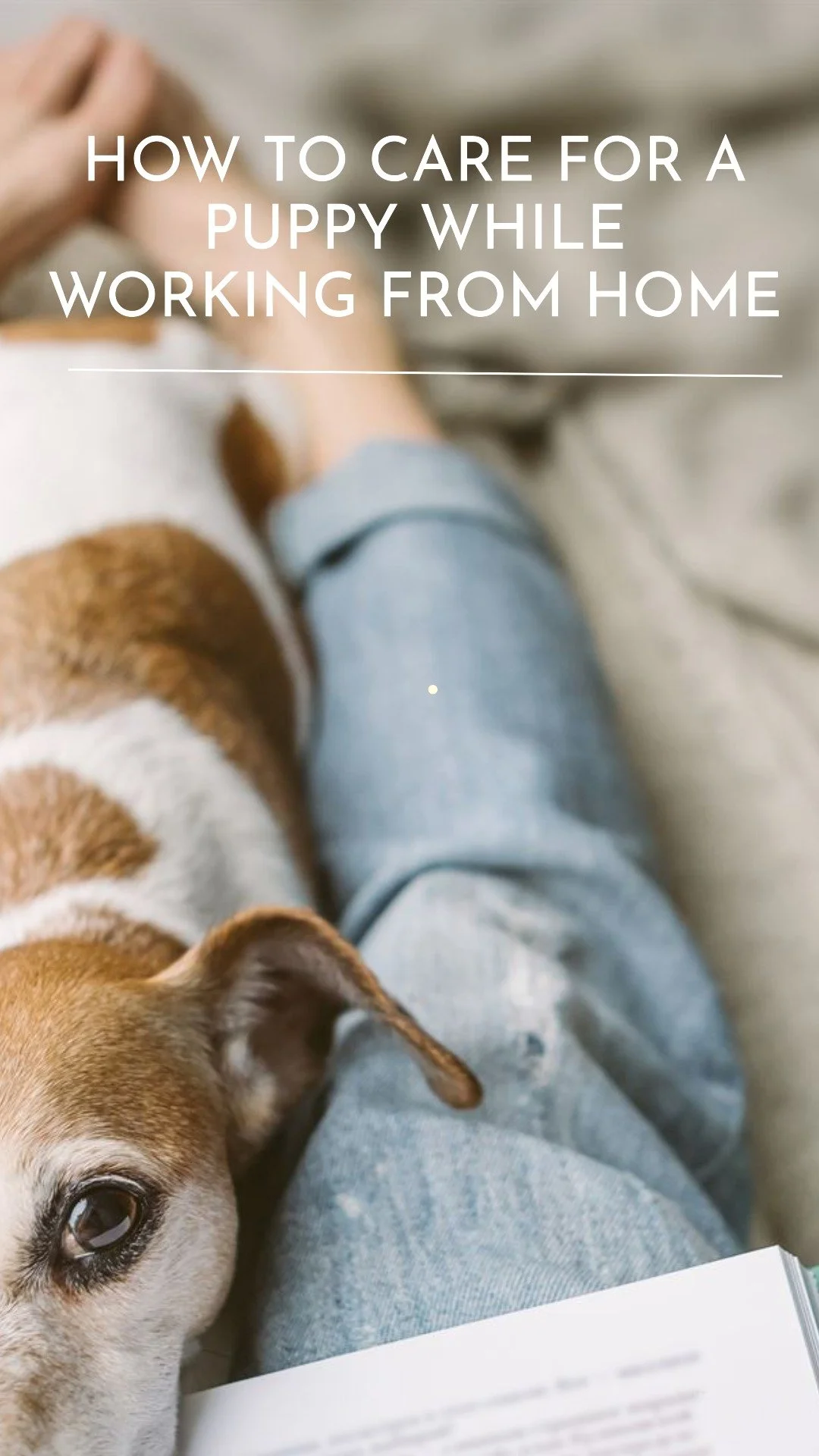What to Do With A Puppy While Working From Home: A Complete Guide
/Welcoming a new puppy into your home is exciting but can come with a few challenges – especially when you're working from home.
From managing your puppy's energy levels to tackling puppy potty training, it can be tricky to find a balance that keeps both you and your new furry friend happy.
As a remote worker, you might be dealing with "puppy work at home anxiety". You're not alone.
Many people have sought out "puppy work at home solutions" to help them create a harmonious home and work environment.
This article provides a comprehensive guide on how to care for and train a puppy while working from home, offering essential tips for leaving a puppy alone during remote work, and more.
So, whether you're in the middle of setting up a designated workspace for remote work with a puppy or you're trying to figure out the pros and cons of puppy work at home, this article has got you covered.
Establishing a Healthy Routine
Creating a stable routine is a fundamental aspect of puppy care. It ensures your puppy feels secure and helps them understand what's expected of them. Here's how to establish a workable routine for you and your puppy when working remotely:
1. Feeding Times:
Start by setting specific feeding times. Puppies usually eat three times a day: morning, noon, and evening. Make sure to time your puppy's meals to suit your work schedule.
2. Play Time:
Puppies have a lot of energy, so it's crucial to schedule regular play times. Try to arrange play sessions during your breaks. Not only does this help burn off your puppy's energy, but it also allows you to take a well-deserved breather.
3. Nap Time:
Like babies, puppies sleep a lot. Encourage nap times after meals and playtimes. This can provide quiet periods for you to focus on your work.
4. Training Time:
Spare some time for puppy training at home. These sessions can be short, around 15 minutes, and done multiple times a day. It's a great way to instill obedience early and reduce the challenges of puppy work at home.
5. Potty Breaks:
Remember that puppies have small bladders. Aim for a potty break every 1-2 hours, after meals, playtimes, and naps. This helps with your puppy potty training and prevents any unexpected accidents.
6. Designated Alone Time
Teach your puppy that it's okay to be alone. You could use this time to focus on your work, and it will help alleviate any separation anxiety your puppy may experience.
An example of a "puppy work at home schedule template" could look like this:
| Time | Activity |
|---|---|
| 8:00 AM | Breakfast |
| 8:30 AM | Quick Play Time/Potty Break |
| 9:00 AM | Nap Time |
| 10:30 AM | Potty Break |
| 12:00 PM | Lunch/Play Time/Potty Break |
| 12:30 PM | Training Time |
| 1:00 PM | Nap Time |
| 2:30 PM | Potty Break |
| 5:00 PM | Dinner/Play Time/Potty Break |
| 5:30 PM | Training Time |
| 6:00 PM | Nap Time |
| 8:00 PM | Play Time/Potty Break |
| 10:00 PM | Bed Time/Potty Break |
Of course, you can adjust this schedule to best fit your work hours and your puppy's needs.
Pro Tip: Keep a consistent schedule even on the weekends to ensure a routine that your puppy can rely on.
Remember, the idea is to strike a balance between work and puppy care. The routine will likely need some tweaking initially, but with patience and consistency, you'll establish a system that works for both of you.
Balancing Puppy Care and Work
Maintaining a healthy work-life balance when you have a puppy at home can seem daunting, but with a few strategies, you can manage both efficiently.
Set Up a Dedicated Workspace
Setting up a designated workspace is key for remote work with a puppy. It helps establish boundaries and allows you to concentrate on your tasks. If possible, use a room with a door to minimize distractions during important calls or focused work periods.
Use Quiet Toys During Work Hours
Puppies are bundles of energy, and keeping them entertained while you're trying to work can be a challenge. A helpful solution can be investing in quiet toys for puppies. Interactive toys, such as puzzle feeders or chew toys, can keep them busy for long periods without causing a ruckus. These toys also help with mental stimulation, keeping your pup happy and satisfied.
Enlist Help When Needed
There's no shame in seeking help when balancing work and puppy care. Consider hiring a dog walker or a puppy sitter, especially during your busiest work hours. If it's within your budget, you might also consider doggy daycare. This service provides your pup with an opportunity to socialize and lets you focus on your work without interruptions.
Take Regular Breaks
Remember to take regular breaks to play and engage with your puppy. Not only does this provide the exercise and interaction your pup needs, but it also gives you a much-needed break from screen time. A game of fetch or a short walk can do wonders for both of you!
Keep Up with Training
Training your puppy shouldn't stop just because you're working. Integrating small training sessions throughout the day can be highly beneficial. Teach your puppy commands during breaks or try incorporating training into playtime. For instance, you could work on "sit" or "stay" before throwing a toy.
Creating a Puppy-Friendly Home Office Environment
Making your home office environment puppy-friendly is essential in managing work and puppy care simultaneously. Here's how to create a safe and conducive environment:
Puppy-Proof Your Home Office
Puppy-proofing your home office means creating a space that's safe for your puppy to explore. Here are some ways to do it:
Secure Loose Wires: Puppies are curious creatures and will chew on anything, including wires. Use cord protectors or secure loose cables out of your puppy's reach.
Remove Toxic Plants: Some houseplants can be toxic to dogs. Ensure none of these are within your puppy's reach.
Lock Away Hazardous Items: Office supplies like staplers, paper clips, and pens can be choking hazards. Keep these in drawers or high shelves.
Comfort Zone: If there's enough space, set up a comfy spot for your puppy within your sight but away from your working area. This way, they can stay close to you without causing distractions.
Keep Essentials Close: Have a stash of puppy essentials like treats, toys, and puppy pads near your workspace. This way, you can quickly address your puppy’s needs without disrupting your work.
Ensure Good Ventilation: If you're working in a confined space, make sure it's well-ventilated and comfortable for both you and your puppy.
Choose the Right Equipment
Invest in some puppy-friendly office equipment. Consider getting a quiet keyboard if your puppy is disturbed by the noise or a standing desk that allows you to keep an eye on your puppy while working.
Use Noise-Cancelling Headphones
Invest in a good pair of noise-cancelling headphones for those times when your puppy is particularly playful or noisy. This can help you concentrate on your work, especially during meetings or when working on demanding tasks.
Managing Puppy Separation Anxiety While Working from Home
Puppy separation anxiety can be a challenging aspect of remote work with a puppy. However, with patience and consistency, you can effectively manage it. Here are some strategies:
Gradual Desensitization
Gradually get your puppy used to being alone. Start with short periods of separation and gradually increase the time. Use positive reinforcement like treats and praises when your puppy remains calm during your absence.
Keep Your Puppy Occupied
Interactive toys and puzzles can keep your puppy engaged while you're working. Consider toys that you can fill with treats to make them more attractive and engaging.
Create a Comfortable Environment
Make sure your puppy has a comfortable and safe place to relax while you're working. This could be a crate or bed in your home office or another part of the house.
Consider Professional Help
If your puppy's separation anxiety persists or seems extreme, it may be time to consult a professional. A dog trainer or behaviorist can provide you with strategies tailored to your puppy's needs.
Use Calming Aids
There are various calming aids available in the market that can help soothe anxious puppies. These include calming treats, diffusers, and even calming music specifically designed for dogs.
Positive Reinforcement
Whenever your puppy manages to stay calm when you're not in the room, reward them with praise, treats, or toys. This encourages them to associate being alone with positive experiences.
Use a Baby Monitor
This can help you keep an eye on your puppy without being in the same room. You can easily step in if you notice signs of distress or destructive behavior.
Remember, each puppy is unique, and what works for one may not work for another. It may take a bit of trial and error to find what works best for you and your puppy.
Wrapping Up: Balancing Work and Puppy Care
If you've been wondering how to strike a balance between work and puppy care while working from home, you're not alone. It's a challenge, but with careful planning and patience, it can be an incredibly rewarding experience.
Let's quickly recap our top tips for managing puppy care and maintaining productivity when working from home:
Establish a Routine: Consistency is key when it comes to managing a puppy and work. A well-structured schedule makes things easier for both you and your puppy.
Create a Puppy-Friendly Workspace: A designated workspace that is safe and puppy-proof can help you focus on your work and keep your puppy out of mischief.
Break Times are Essential: Regular breaks not only help maintain your productivity, but they also provide valuable bonding and playtime with your puppy.
Engage Your Puppy: Keep your puppy engaged with a variety of toys and puzzles. This not only keeps them entertained but also stimulates their mental development.
Manage Separation Anxiety: Gradual introduction to alone time, a safe space, and consistent routines can help ease separation anxiety in puppies.
Reach Out for Help: If balancing work and puppy care gets overwhelming, consider hiring a dog walker or using a doggy daycare.
Remember, every puppy is unique, so feel free to tweak these tips to fit your and your puppy's needs best. Working from home with a puppy can be a balancing act, but with some time, patience, and a lot of love, you'll both settle into a routine that works for you.
Working At Home With A Puppy: Frequently Asked Questions
Got questions about working at home with a puppy? Here are some answers to some of the most common questions about the topic.
Q: How long can a puppy be left alone at home?
A: Puppies should not be left alone for more than 4 hours at a time. It's important to provide regular breaks, exercise, and mental stimulation during your workday.
Q: How do I keep my puppy entertained while I work from home?
A: Provide interactive toys, puzzles, and engaging activities for your puppy. Consider hiring a dog walker or using puzzle feeders to keep them mentally stimulated.
Q: How can I train my puppy while working from home?
A: Establish a consistent routine, use positive reinforcement techniques, and consider enrolling in puppy training classes. Set aside dedicated time for training sessions.
Q: What should I do if my puppy has separation anxiety while I work from home?
A: Gradually introduce short periods of alone time, create a safe and comfortable space for your puppy, and consider using calming aids or seeking professional advice.
Q: Should I crate my puppy while working from home?
A: Crating can provide a safe and secure environment for your puppy while you work. Proper crate training techniques should be followed to ensure their comfort.
Q: What are some indoor activities for puppies while working from home?
A: Some indoor activities for puppies while working from home include playing with interactive toys, engaging in training sessions, or watching dog-friendly apps and channels.
Q: How do I manage my puppy's bathroom breaks while working from home?
A: You can manage your puppy's bathroom breaks while working from home by establishing a consistent potty training routine, taking regular breaks, or using indoor potty solutions like puppy pads or litter boxes.
Q: Can I hire a dog walker to help with puppy care during work hours?
A: Yes, you can hire a dog walker or pet sitter to help with puppy care during work hours, which can alleviate some of your workload and ensure your puppy is adequately exercised and cared for.
Q: How do I prevent my puppy from getting bored while I work from home?
A: To prevent your puppy from getting bored while you work from home, you can provide them with engaging toys, set up play dates with other dogs, or consider dog-friendly apps and channels for mental stimulation.
Q: Are there any online puppy training resources for remote workers?
A: Yes, there are numerous online puppy training resources available, including video tutorials, webinars, and digital training guides specifically tailored for remote workers.
Want more? Check out these articles for products to help you build the best home office setup in the world:
About the Author
Andrew Macarthy has worked from home for over a decade. He is a social media consultant and the author of the #1 Amazon Web Marketing Bestseller, 500 Social Media Marketing Tips - with over 150,000 copies sold to date.













